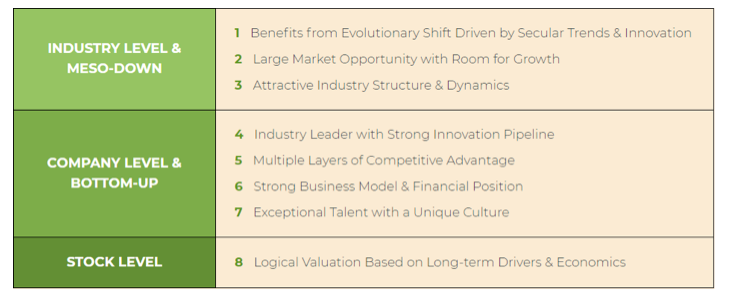Furthermore, not all growth companies are innovators. Many so-called “growth companies” can grow through roll-up strategies and acquisitions, by taking on debt to expand capacity, or grow through unit or geographic expansion. While these growth drivers are not bad, per se, we believe that growing through innovation—the development of next-generation products and services, with tech-enabled business models—creates more defendable businesses with greater differentiation. These elements are critical for reducing competitive risk, as well as providing the fuel for sustainable growth. Innovative businesses are potentially higher quality than mere “growth companies.”
Innovation investing is all about focusing on identifying true innovators and being earlier to spot them, getting ahead of growth investors who are chasing growth in the rearview mirror. Focusing on innovation enables investors to look through the windshield at what is coming down the pike. And, that gives this new third style of investing—innovation investing—a competitive advantage versus growth and value investing.
Hortz: How does your investment process identify important innovative businesses, or as you call them quality innovators?
Ricketts: As we have been discussing, we believe traditional investment processes are inadequate, if not ill-suited, to keep pace with the accelerating change happening across the economy. As a result of this insight, our investment team’s starting point is unconventional by design. It does not rely on traditional growth screens, or Street research, much of which we view as backward-looking or highly short-term oriented.
It’s important to remember that investors only get paid on future growth in earnings and cash flow, not past growth. As such, we begin our process by analyzing the root causes of future growth for companies and industries. In our experience, these root drivers are typically a series of new innovations that, in turn, drive industry secular trends and multi-year periods of above-average growth. Types of innovation that the investment team identifies and tracks, include: technological innovation, product innovation, service or experience innovation, process or cost innovation, brand innovation, and business model innovation. The great innovators of our time combine multiple types of innovation to create value and competitive advantage. Ultimately, the investment team’s objective is to identify the most important innovations, understand how these cause secular trends, and ultimately, identify and own the leading innovators at the vanguard.
Every investment is evaluated by our research team based on a disciplined set of eight investment criteria. In my experience, successful investments have a few key ingredients, such as finding an attractive industry, identifying the leader, and getting in early, while paying a fair price. Our eight investment criteria capture these core elements but from an innovation-focused vantage point:

Hortz: We have touched on innovation, but tell us how the evolution piece contributes to your investment approach? It must be important given you named the firm, Evolutionary Tree Capital Management.
Ricketts: Innovation is important, but it is only part of the story. We like to say the “equation” for wealth creation is: Innovation + Evolution = Opportunity.
Innovation—or a series of innovations—is what fundamentally forces change across industries and the whole economy. As these innovations are introduced in different industries, they cause structural change—evolution—that may drive multi-year secular growth. Innovations are the building blocks for next-generation products or services. When successful, they drive a shift from the old generation to the next generation. We call these evolutionary shifts, and they offer both opportunity and risk for investors. Evolutionary shifts are now happening more frequently, especially with the rise of digital transformation.
In decades past, innovations arose at a slower pace and were absorbed by incumbents with less disruption. Today, with accelerating change, new innovations can drive profound structural changes within and across industries—creating both long-term growth opportunities for leading innovators and risk to those firms failing to adapt. The days of graceful maturity for incumbents have given way to next-generation products or services displacing less innovative offerings.
Examples of evolutionary shifts can be found in most industries and include the shift from traditional retail to e-commerce, the shift from client-server computing architecture to cloud computing and software-as-a-service, and the shift from traditional media to video streaming.








